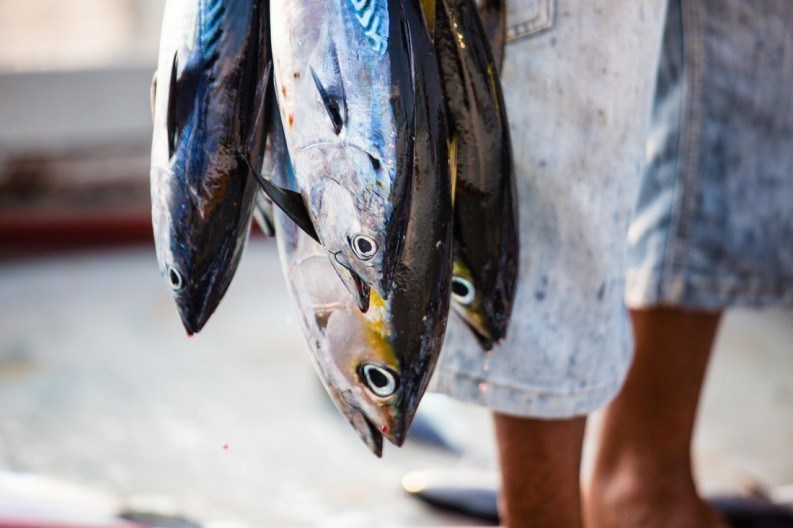The state of tuna stocks
Worldwide there are 23 stocks of the major commercial tuna species (6 albacore, 4 bigeye, 4 bluefin, 5 skipjack and 4 yellowfin stocks). A recent report from the International Seafood Sustainability Foundation (ISSF) shows that 48% of tuna stocks are at a healthy level of abundance, 39% are overfished and 13% are at an intermediate level.Skipjack stocks, which make up more than half of global catches, are generally healthy. However, all populations of bluefin and 2 out of 6 albacore stocks are overfished and some yellowfin stocks are declining. According to ISSF, 13% of the total tuna catch comes from stocks where fishing in not well managed.
Global catch of tuna has tended to increase consistently, from less than 0.6 million tonnes in 1950 to more than 6 million tonnes today (UN FAO). With these trends continuing there is an urgent need not only to reduce fishing pressure on those stocks already overfished, but to protect and effectively manage those currently in a healthy state.
Effective management is required now to ensure that all tuna stocks can be rebuilt where needed and maintained at sustainable levels into the future.

A global management challenge
Tuna are highly migratory species and are managed by Regional Fisheries Management Organizations (RFMOs). There are 4 primary RFMOs charged with conserving and sustainably managing tuna stocks in the Western and Central Pacific Ocean, Eastern Pacific Ocean, Indian Ocean, and Atlantic Ocean. These organisations each comprise between 21 and 50 member countries, and consensus is required to reach a decision. Historically, tuna RFMOs have struggled to make timely decisions when faced with declines in stocks, increases in fishing effort, and changes in fishing practices.An effective approach to dealing with fish stock declines is the use of Harvest Control Rules (HCRs) which define how catches should be reduced if a fish population declines. HCRs are recognised as best practice in fisheries management. They are tied to scientifically derived reference points and are incorporated in the MSC Fisheries Standard.
A fishery’s stocks usually decline because the number of young fish coming into the population has been low or catches have been too high. To use an analogy, this is like a business that finds itself with lower sales than expected, or higher expenditures. Either circumstance can damage the company’s balance sheet and put it at risk. If the board of a business does not react rapidly, the business can go bankrupt. The business needs to respond quickly to save the business, and likewise, RFMOs need to respond quickly when stocks decline.
HCRs that are pre-agreed, well defined and scientifically tested can be triggered much faster, and with more reliable effect, than simply asking the management authority to consider each situation independently. This is particularly important with tuna and other highly migratory stocks managed by RFMOs since the decision making body is made up of many independent states, and a consensus is needed. This situation can delay decision making by many years, and when fish stocks start to drop, delays in adopting conservation measures almost always lead to further decline.
What can be done to safeguard tuna?
By setting robust and credible requirements for sustainable fishing, the MSC provides a benchmark that all tuna fisheries can work towards in order to ensure their long term viability and the protection of the marine environment.Market incentives, in the form of preferential purchase of MSC certified tuna, reward sustainable fisheries for implementing these practices.
Currently around 721,000 MT of tuna caught per year is MSC certified – representing around 15% of total tuna catches. We would like to see more tuna being certified to the MSC standard and sold with the MSC ecolabel. However, to achieve and maintain MSC certification tuna fisheries need to have effective policies in place to ensure the sustainability of tuna fisheries into the future.
Room for improvement
The assessments of most tuna fisheries to the MSC Fisheries Standard have identified the need for one or more aspects of the fishery to be improved to ensure continued certification. This may require improvements to or adoption of HCRs.Responding to the need for well-defined HCRs, and pressure from some fisheries wishing to achieve or maintain MSC certification, a number of RFMOs are intensifying their efforts to improve HCRs for many stocks.
The MSC encourages fisheries, NGOs and retailers to work together to encourage RFMOs to adopt the measures needed for fisheries to protect tuna stocks and ensure long-term, science-based management of these critical fisheries.
